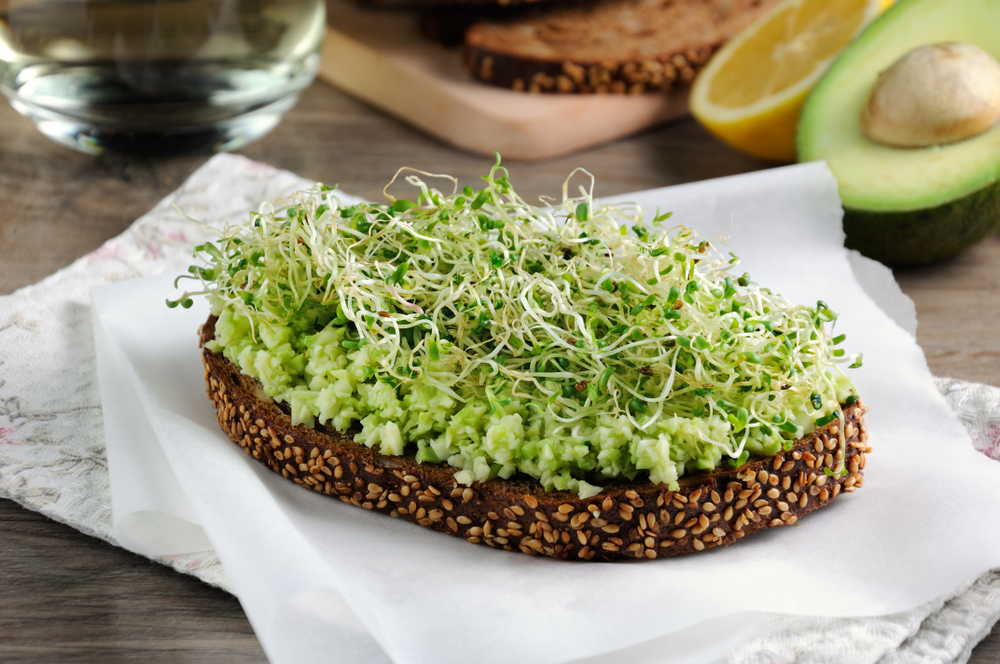
Most of us have heard of alfalfa but may not be familiar with the health benefits. If you’re wondering how to use alfalfa in your cooking, as medicine, and throughout your home, we’ll explain all the benefits of the amazing Medicago sativa plant.
Alfalfa has been popular for many years as food and medicine. The alfalfa herb is full of vitamins, minerals, and beneficial health properties that you won’t want to miss. Here are all the ways to use alfalfa in your day-to-day life for health and wellness.
How to Use Alfalfa: Medicago Sativa of Fabaceae
Wondering how to use alfalfa? Is it primarily used in the sprout form, or are there other beneficial ways to use this plant?
The first and most straightforward way to use alfalfa is to add it to your food. What better way to make a salad even more nutritious than adding an herb and veggie jam-packed with numerous vitamins and micro-nutrients? There are also supplements and other ways to use this powerful herb. Let’s explore a little more about alfalfa and why it’s so amazing.
Alfalfa, also known as “Lucerne” or Medicago sativa, is a perennial crop grown throughout the United States and worldwide. It’s the fourth largest acreage crop in the U.S.
Although the alfalfa crop was grown by early U.S. settlers, it didn’t take off until the mid-1800s, when it was grown as a primary source of livestock feed, particularly in the west. Today it’s harvested in large swaths and sun-dried. After drying, the alfalfa is raked and baled. Alfalfa can often regrow several times a year, making it a lucrative plant to harvest. It’s the third-highest value crop in the United States.
Most alfalfa is bred to be pest resistant. In addition, the crop improves the quality of the surrounding soil, making it a critical rotation crop for farmers. Many birds and animals rely on alfalfa for food and even shelter. There are over a hundred bird species that use alfalfa fields as shelter, as well as for food. It is also the main source of food for many dairy cows.
What’s more, alfalfa is full of health benefits for people as well as livestock. It is valued for its exceptional vitamins, minerals, and protein content.
Alfalfa sprouts beautiful blue and purple flowers. When ripe, the fruit is black or brown and contains tiny yellow seeds with an irregular kidney shape. Alfalfa is part of the legume family, but it’s also considered an herb. There are many ways to use alfalfa for its medicinal and nutritional benefits.
We’ll explore how to use alfalfa, the benefits of alfalfa to people throughout the world, and some practical ways to incorporate it into your diet.
Alfalfa Benefits Throughout the World
Historically, alfalfa seems to have originated in Iran, where traces of 6000-year-old alfalfa were found. There are thousands of years old writings about the crop, and historians believe it was domesticated in Turkey, Iran, or other central Asian countries and the Middle East. Greeks and Romans used alfalfa to feed horses, and the word alfalfa is an Arabic word meaning “horsepower” or “horse fodder.”
From Greece and Rome, alfalfa spread through North Africa, to Spain, and then through Europe and Russia. Spanish colonizers brought it to Mexico and Peru, and from there, it spread through South America. Early European settlers brought it to North America, where they referred to it as lucerne (a name also used in the U.K., Australia, and New Zealand).
Ancient Arabs fed alfalfa to their horses to enhance their speed. Alfalfa is used in traditional Chinese medicine for appetite and digestion. Many cultures have used alfalfa for soothing injuries and skin afflictions, as well as strengthening bones and the immune system. In India, alfalfa is often used as a poultice to cool and soothe. Leaves are still used for chlorophyll supplements, and the seeds are used for yellow dye.
Alfalfa is high in vitamin K and has some scientifically proven coagulating properties; historically, many cultures used it to stop bleeding and heal wounds. Settlers introduced alfalfa to Native Americans in the mid-1800s, and many adapted alfalfa into their medicine. For example, they ground seeds into flour for bread and ate the sprouts and shoots.
Alfalfa is also used throughout folklore and medicine. Lore says that alfalfa can bring prosperity and protection. Some believe you should burn alfalfa and spread the ashes around your buildings and properties to protect your wealth. Others keep dried alfalfa in the kitchen cupboard to ward against hunger, poverty, and unhappiness. Strands of alfalfa can be woven together to create a protective amulet, particularly during travel and financial transactions.
Alfalfa is also known for bringing good luck in gambling. People may carry a few alfalfa leaves with them when they go to the casino to increase their chance of winning. Generally, it is believed to be auspicious for all money matters. It “plays well” with other lucky herbs like basil and goldenseal to bring even more luck and protect against scarcity and financial predicaments. People likely based many of these associations on the idea that when livestock was well-fed, people often prospered.
Taxonomy of Alfalfa
Kingdom: Plantae
Clade: Angiosperms
Clade: Endicotts
Order: Rosids
Family: Fabaceae
Genus: Medicago
Species: M. Sativa
Binomial Name: Medicago sativa
How to Use Alfalfa for Health & Nutrition
If you’re wondering how to use alfalfa to get some of the tremendous benefits, it’s simple. The easiest way to get alfalfa in your diet is to consume alfalfa sprouts. You can often find them in the produce section in health food and grocery stores. Sprouts are nutrient-dense and high in vitamins like vitamin K and C. Other nutrients include fiber, copper, folate, and manganese.
Alfalfa sprouts are mild tasting. They’re ideal for salads and sandwiches. You can also mix them in many vegetable dishes. Sprinkle sprouts atop soup or use them to garnish dishes and add a beautiful finishing touch.
You can also supplement sprouts in tablet or powdered form. You can use the powder to make alfalfa tea—alfalfa has a slightly grassy, bland taste.
What else is alfalfa used for? How do you use alfalfa for health? Well, herbalists believe that the humble alfalfa plant may have anti-cancer properties in the form of phytoestrogens and antioxidants. They can help reduce inflammation in the body.
The leaves of alfalfa have antibacterial properties. The plant is a natural diuretic and high in fiber, making it ideal for constipation. People historically used alfalfa to treat digestive disorders like constipation and ulcers. In addition, the fiber content can help regulate blood sugar in people with diabetes. It can also help to treat menopause and irregularities in menstruation, thanks again to the phytoestrogens, high fiber, and blood-clotting effects of Vitamin K.
Alfalfa sprouts are extremely low in calories but are a great way to “bulk up” food, helping you feel full and energetic. Some studies show alfalfa sprouts play a role in lowering high cholesterol and boosting the immune system too. Because the sprouts are very high in vitamin C, they can support immunity.
Alfalfa has a significant amount of protein as well. The high protein content is satiating and can help workout and injury recovery, muscle mass repair, and more. Magnesium, iron, and vitamin K, as well as calcium in the sprouts, support bone health and help treat osteoporosis. The anti-inflammatory effect may also help with rheumatoid arthritis, but it’s important to discuss with your healthcare provider because alfalfa sprouts can also pose a risk for those with autoimmune concerns. The high magnesium content can alleviate headaches and migraines and help reduce pain in the body.
Finally, alfalfa sprouts are great for the skin. They contain many antioxidants that help heal the skin and reduce blemishes and wrinkles.
A word of caution about alfalfa use and consumption: you should avoid alfalfa during pregnancy, as it may cause uterine contraction and stimulation. It’s also important to note that salmonella outbreaks have occurred due to improperly stored and harvested sprouts. For this reason, you should avoid eating fresh alfalfa sprouts (homegrown or store-purchased) if you have a compromised immune system or during pregnancy and breastfeeding. There is some evidence that phytoestrogens can help support lactation, but it’s essential to check with your doctor to weigh the risks of consumption of alfalfa during breastfeeding.
Generally, older adults and infants should avoid eating raw sprouts, but they are safe for most other healthy people. Because of the risk of salmonella, use caution when eating sprouts and always rinse the sprouts before eating them. In addition, alfalfa can affect the blood, so people with certain health conditions, autoimmune diseases, or those taking anti-rejection pills for transplants or anticoagulant drugs should not consume alfalfa. As always, check with your doctor before incorporating any supplement into your diet.
How to Grow Alfalfa at Home
Alfalfa is extremely easy to grow at home. In fact, you can sprout alfalfa seeds in a jar, right in your own kitchen. Look for organic, chemical-free seeds and place two teaspoons of seeds into a sterilized glass jar. Cover the jar with a breathable cloth such as cheesecloth or a mesh sprouting lid. Soak the seeds, rinse them, and drain them twice per day. After 3-4 days, you will begin noticing sprouts, which will grow to edible size in about a week.
If you want to grow full alfalfa plants for herbal tea and drying, it’s best to start with chemical-free seed sprouts and transfer them to your garden. Alfalfa requires deep soil to grow. It requires phosphorus and potassium for optimal health, although the plant acclimates readily in many different growing zones and conditions.
To harvest alfalfa, pick the leaves when the plant is in bloom. Alfalfa favors warm temperatures and subtropical or semi-dry climates, but it’s easy to grow and can be an interesting addition to your herb garden.
Alfalfa is a fascinating plant, rich in vitamins and nutrients. For hundreds of years, people have used the alfalfa herb to treat a variety of illnesses and improve the health of both people and livestock. Although it’s commonly thought of as food, it can also be a nourishing natural medicine. The sprouts are easy to use and an enjoyable way to increase the nutrition in your meals. This humble alfalfa herb’s many uses is a display of nature’s wonders.
What do you think of alfalfa sprouts? Have you added them to your salad or sandwich? Let me know in the comments!
For more herb ideas, don’t miss:
- How to Use Allspice (Pimenta Dioica)
- All About the Agrimony Herb
- Turmeric: Spiritual and Medicinal Uses in Ancient Cultures








Leave A Reply!